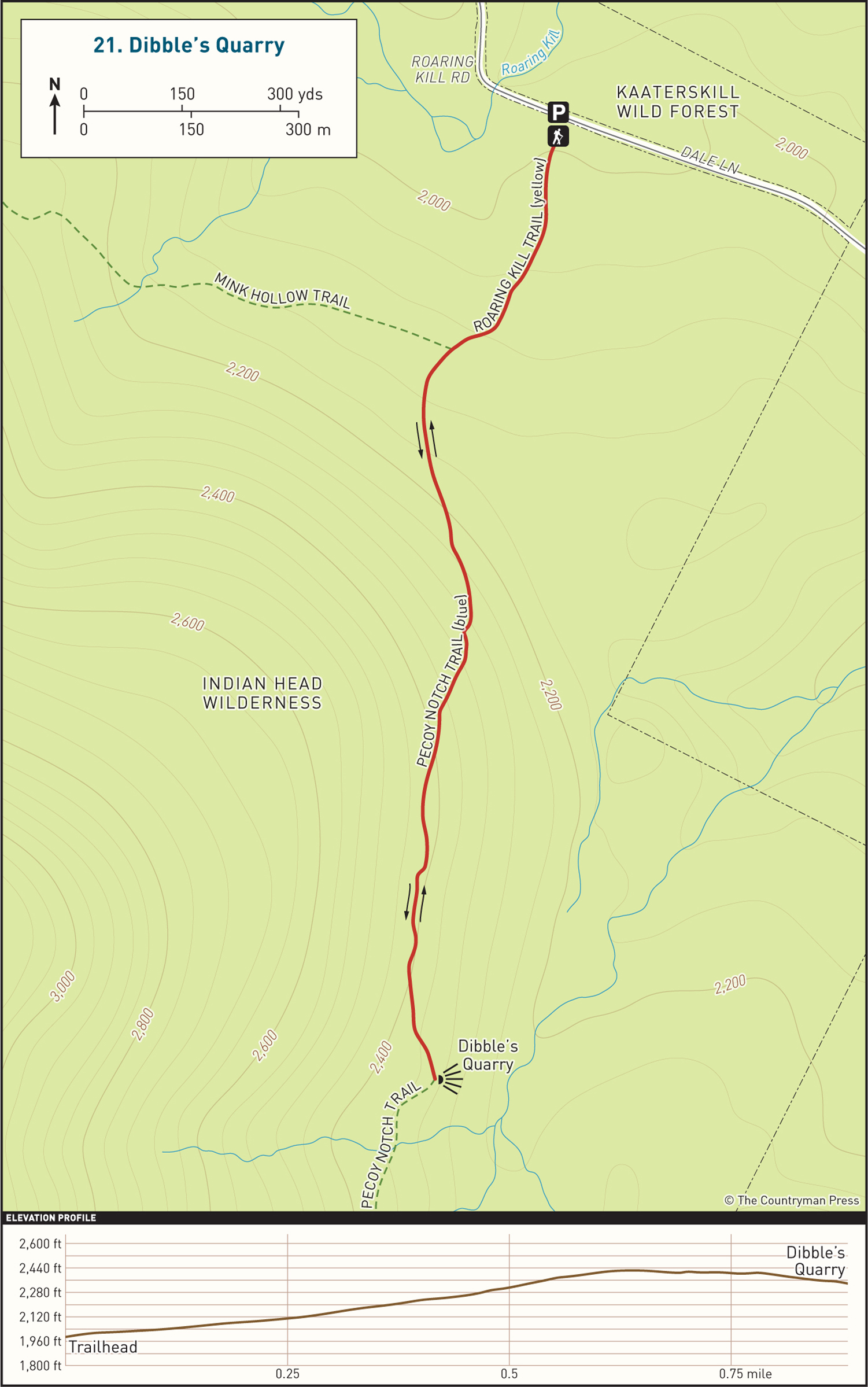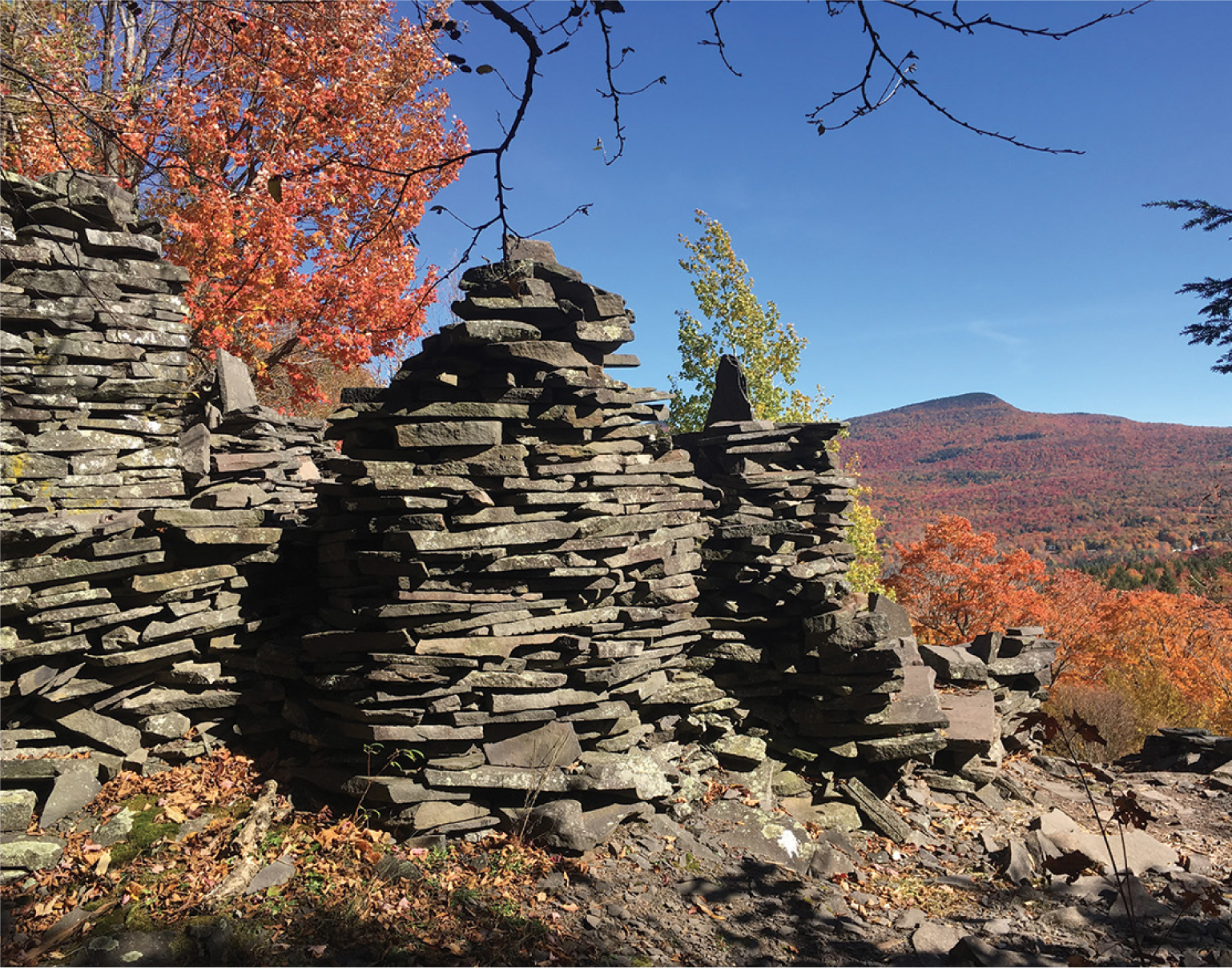
|
DISTANCE: 2 miles TYPE: Out and back TOTAL ELEVATION GAIN: 340 feet MAXIMUM ELEVATION: 2,350 feet DIFFICULTY: Easy HIKING TIME: 1.5 hours |
As the name would imply, Dibble’s Quarry was once mined for bluestone, which was used as a building material in years past. The quarry is no longer operational, but what remains is a sight to behold. Unknown persons working laboriously over the years (or maybe Sasquatch—we shouldn’t rule it out) have spent countless hours building makeshift towers, tables, and chairs with the flat, smooth rocks. An excellent expedition for explorers seeking maximum payoff for minimal effort, this easy hike is very attractive to young and old alike, offering sweeping views of the surrounding mountains and the valley below. Dibble’s Quarry can be visited on its own, or combined with more strenuous hikes like Twin Mountain (Guide #20) and Sugarloaf Mountain (#22), since the trail beyond the quarry eventually meets with the Devil’s Path.
GETTING THERE
Take Exit 20 (Saugerties) from the New York State Thruway, then turn left onto NY-212/NY-32. At the traffic light, take a right onto NY-32 North. In 6 miles, continue straight onto NY-32A. In 1.9 miles, turn left onto Route 23A, and drive up the winding mountain road toward Tannersville. At the traffic light in Tannersville, take a left onto NY-16/Platte Clove Road. Continue south for 5 miles, then turn right onto Dale Lane. Follow Dale Lane for 1.2 miles. The parking area is just before Dale Lane becomes Roaring Kill Road.
GPS SHORTCUT
Type “Roaring Kill” into Google Maps and your GPS will navigate you to the appropriate trailhead.
Enter the woods at the southern end of the parking lot and begin an easy walk up the rooty, yellow-blazed Roaring Kill Trail. The trail climbs very gradually, crossing two seasonal streambeds along the way. After crossing the second creek bed, the trail will become a little rockier as the forest opens up. In 0.25 mile, the Roaring Kill Trail ends at a trail junction. Going right will send you on the Mink Hollow Trail, while going left will put you on the Pecoy Notch Trail. Both trails are blazed blue. Turn left here and begin ascending up the Pecoy Notch Trail.
The trail climbs moderately along the side of a hill, through serene mixed forest. You will pass several boulders and large rocky ledges as you continue. When you start to level off, you will notice some small chairs made out of stone along the side of the trail. At times this area can be wet and muddy, but there are solid stepping-stones lining the path, so you should have no problem staying dry.
The trail will start to turn to the left as you pass through a large grove of hemlock trees. Descend over a small stone ledge on rocky steps and follow the trail as it cuts to the right. At this point, the trail emerges from the tree cover, arriving at Dibble’s Quarry 0.75 mile from the start of the Pecoy Notch Trail. The quarry area is perched on the side of the hill and offers expansive views to the east. You can see the distinctive profile of Round Top Mountain and Kaaterskill High Peak to your left, and the northwestern summit of Twin Mountain to your right, with the Platte Clove Valley spreading out into the distance between the two. You will want to set aside a good amount of time to explore this area. There are little stony trails leading all over the quarry, to man-made walls and fences.

SCENIC VIEWS OF KAATERSKILL HIGH PEAK FROM DIBBLE’S QUARRY
Perhaps the highlight of the quarry is a medieval-looking court up a short staircase, complete with two thrones made out of bluestone. There are several other chairs in the area as well, making this a perfect place for a picnic. Early risers would find a real treat in watching the sunrise from here, and they might even catch a fleeting glimpse through the trees of the giant, humanoid cryptids that may or may not have constructed this mysterious place. These sites of stone furniture are truly one of the oddest and most delightful quirks of Catskills hiking—a trailside feature you won’t encounter very many other places in the country.
Up the trail a short distance, there are a few more man-made stone structures, but the real highlight is the throne room. When you are finished enjoying the quarry, retrace your footsteps back to the parking lot. Keep an eye out for large, barefooted footprints in the mud that you certainly did not make—and, indeed, no human could have.
If you continue following the Pecoy Notch Trail, you will eventually cross a stream just above a waterfall, and further on from there, you will reach a beaver pond that gives you good views of Pecoy Notch, which sits between Twin Mountain and Sugarloaf Mountain. The blue blazes end a mile uphill from the quarry, where the trail meets with the red-blazed Devil’s Path.